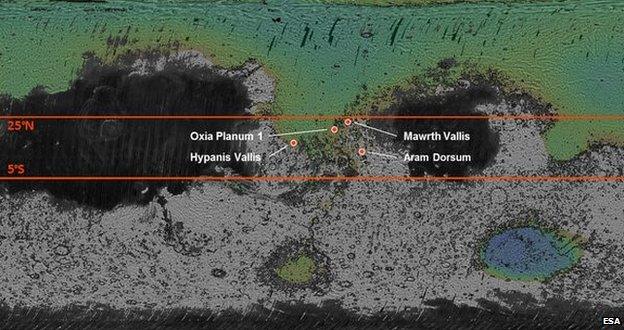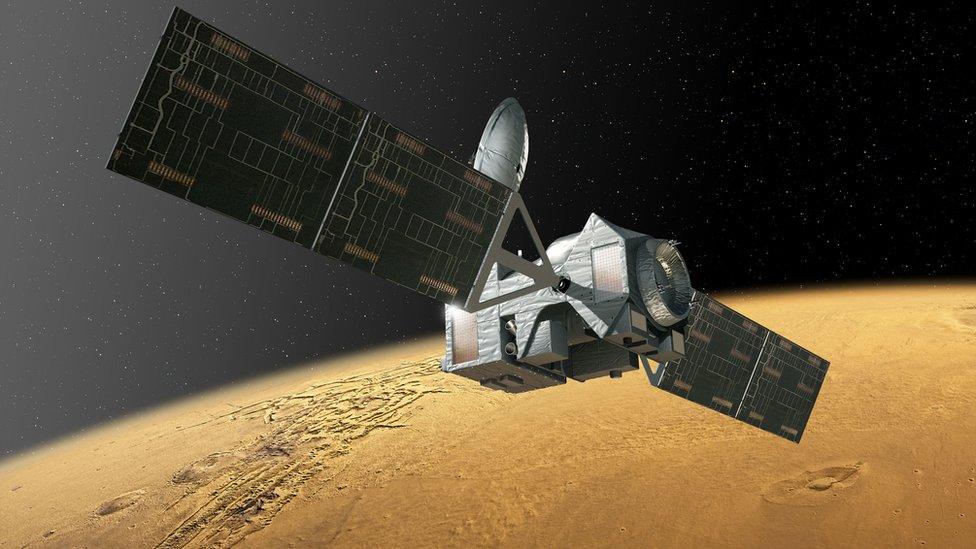Four sites vie for European ExoMars landing
- Published
The European Space Agency has identified the four locations on Mars where it could send a rover in 2018.
They are all ancient terrains where satellite evidence has suggested water was present for prolonged periods.
Esa's ExoMars vehicle will be the first surface rover sent specifically to search for signs of past or present life on the Red Planet.
Previous such robots have concentrated on determining merely whether the world would have been habitable.
ExoMars will have a drill to pull up samples from 2m below ground.
The hope is that its sophisticated lab equipment will be able to detect signatures either of microbial activity today or that took place billions of years ago.
The potential landing sites are named Mawrth Vallis, Oxia Planum, Hypanis Vallis and Aram Dorsum, external.
They have been chosen because of their high scientific interest, but also because they meet tough engineering constraints - that is, the restrictions the available technology places on the mission. The robot cannot simply be targeted anywhere.
For example, all four sites are near the equator. This will give the rover, which will have solar panels, optimal lighting conditions.
The sites are also very low - about 2km or more below datum (the equivalent of sea level on Earth).
This will give the parachute system that puts ExoMars on the surface the maximum amount of atmosphere in which to slow the fast-descending probe.
Mawrth Vallis and Oxia Planum are similar in that they have very thick deposits of clays minerals, as detected from orbit.
Clays form through the alteration of rock in the long presence of water, and water is a requirement for life.
The mineralogy of Hypanis Vallis and Aram Dorsum is not so certain, but these locations display the clear action of past river systems, so water is very obviously part of their history, too.
Candidate landing sites for ExoMars 2018

The candidates' equator locations ensure optimal light conditions
Dusty regions (black) are avoided. Solar panels must be kept clean
All are low enough to allow the use of a parachute system (green)
Targeting too high an altitude (grey) would risk a high-speed impact

What unites them all is that they have interesting places to investigate no matter where the rover touches down.
"The landing ellipse is quite large (105km by 15km). It is very important for us that possible targets for science are everywhere in that ellipse, so that no matter where we come down we are on top of, or within a short drive of, things we can go look at," ExoMars project scientist Jorge Vago told BBC News.
Esa has asked for the help of the US space agency (Nasa) in getting more detailed pictures of the four potential landing sites.
These images will be used by the ExoMars Landing Site Selection Working Group (LSSWG) to narrow the choices.
They will highlight hazards such as boulder fields and steep cliffs - obstacles that could destroy the descending rover.
"With Nasa's high-resolution data, we move into a new stage of - let's say - 'shock and horror' as we realise that none of the sites fulfils the criteria we'd ideally want, 100%," says Dr Vago. A lot of work will be undertaken to model how different landing scenarios might turn out. The choices then become about the most favourable probabilities.
The LSSWG's number one preference could be known by mid-2016, although a final decision will not need to be made for another year after that.
Hurdles ahead
ExoMars has been a long-drawn-out affair, subjected to various programmatic changes and delays.
It came very close to collapse in 2012 when Nasa scaled back its involvement, and was only saved when Russia agreed to pick up key elements of the mission.
These elements include the provision of a rocket to send the rover on its way and the design for a landing system.
ExoMars is now headed for what is termed a Preliminary Design Review in Mid-November.
This will set out precisely how industry intends to build the required technologies. It will be accompanied also by a full, end-to-end costing.
All this information will then be given to European space ministers at their big council meeting in December.
To press ahead with ExoMars, the politicians will have to approve additional funds.
Several hundred million more euros are required to complete the project, over and above the 850 million already committed.
The total budget covers more than just the rover. The ExoMars project is split in two, with a satellite to provide communications (and study the atmosphere) being launched in 2016. Nonetheless, the extra cash is needed to fulfil the surface part of the double mission.
Jonathan.Amos-INTERNET@bbc.co.uk and follow me on Twitter: @BBCAmos, external
- Published27 March 2014
- Published21 June 2013
- Published18 June 2013

- Published5 September 2011